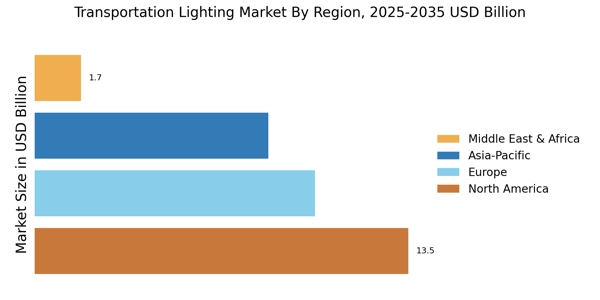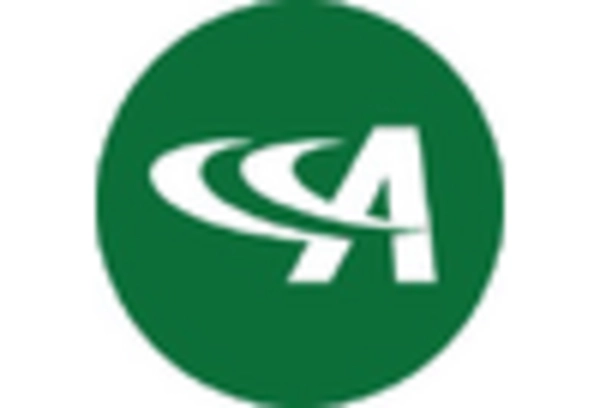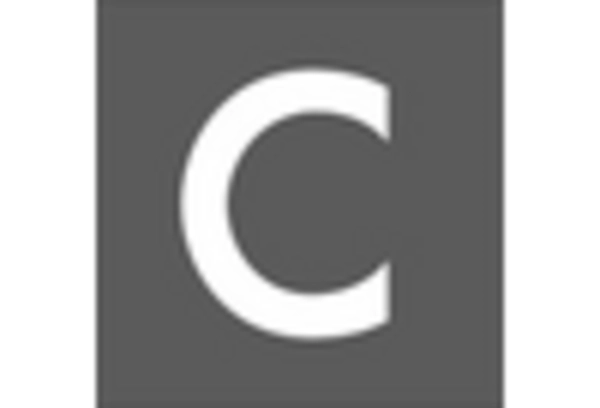Rise of Autonomous Vehicles
The emergence of autonomous vehicles is poised to transform the Transportation Lighting Market in profound ways. As self-driving technology advances, the need for specialized lighting systems that enhance vehicle perception and communication becomes increasingly critical. These vehicles rely on sophisticated sensors and cameras, which require optimal lighting conditions to function effectively. Consequently, there is a growing demand for adaptive lighting solutions that can adjust to the needs of autonomous systems. Market forecasts indicate that the integration of lighting technologies with autonomous vehicle systems could lead to a substantial increase in market size. This trend suggests that the Transportation Lighting Market will not only adapt to the needs of traditional vehicles but also evolve to meet the requirements of future transportation technologies.
Environmental Sustainability Initiatives
The Transportation Lighting Market is increasingly shaped by environmental sustainability initiatives that promote energy-efficient lighting solutions. Governments and organizations are prioritizing the reduction of carbon footprints, leading to a shift towards eco-friendly lighting technologies. The adoption of LED lighting, which consumes significantly less energy compared to traditional options, is a prime example of this trend. Furthermore, initiatives aimed at reducing light pollution are gaining traction, prompting the development of lighting systems that minimize environmental impact. As sustainability becomes a focal point for transportation projects, the market is likely to see a rise in demand for innovative lighting solutions that align with these environmental goals. This shift not only benefits the planet but also enhances the reputation of companies within the Transportation Lighting Market.
Regulatory Compliance and Safety Standards
The Transportation Lighting Market is significantly influenced by stringent regulatory compliance and safety standards imposed by governmental bodies. These regulations mandate the use of specific lighting technologies to ensure the safety of road users. For instance, regulations regarding the brightness and color temperature of vehicle headlights are becoming more rigorous, compelling manufacturers to innovate and adapt their products accordingly. The increasing focus on safety has led to a rise in demand for high-performance lighting solutions that meet these standards. As a result, the market is expected to expand, with a projected increase in revenue from compliance-driven innovations. This trend indicates that adherence to safety regulations is not merely a legal obligation but also a catalyst for growth within the Transportation Lighting Market.
Technological Advancements in Lighting Solutions
The Transportation Lighting Market is experiencing a surge in technological advancements, particularly with the integration of LED and smart lighting solutions. These innovations enhance visibility and safety for vehicles and pedestrians alike. The adoption of adaptive lighting systems, which adjust brightness based on environmental conditions, is becoming increasingly prevalent. According to recent data, the market for LED lighting in transportation is projected to grow at a compound annual growth rate of over 10% through the next few years. This growth is driven by the need for energy-efficient solutions that reduce operational costs while improving safety standards. As municipalities and transportation authorities invest in modern lighting infrastructure, the Transportation Lighting Market is likely to witness substantial growth, driven by these technological enhancements.
Growing Urbanization and Infrastructure Development
Urbanization is a key driver of the Transportation Lighting Market, as cities expand and infrastructure development accelerates. The increasing population density in urban areas necessitates enhanced lighting solutions to ensure safety and security. As urban planners prioritize the development of smart cities, the demand for advanced transportation lighting systems is expected to rise. Recent statistics suggest that urban areas are investing heavily in public lighting systems, with expenditures projected to reach billions in the coming years. This investment is aimed at improving the quality of life for residents and ensuring safe transportation networks. Consequently, the Transportation Lighting Market is poised for growth, driven by the need for effective lighting solutions in rapidly urbanizing regions.

















Leave a Comment